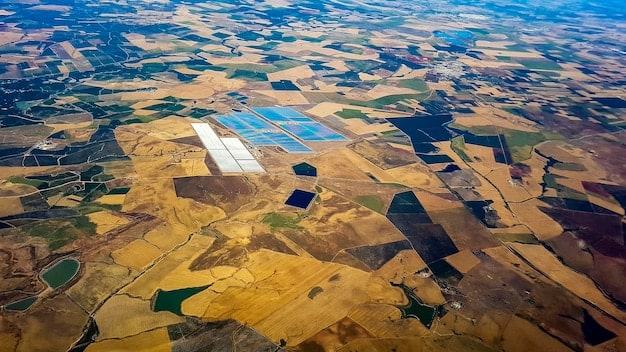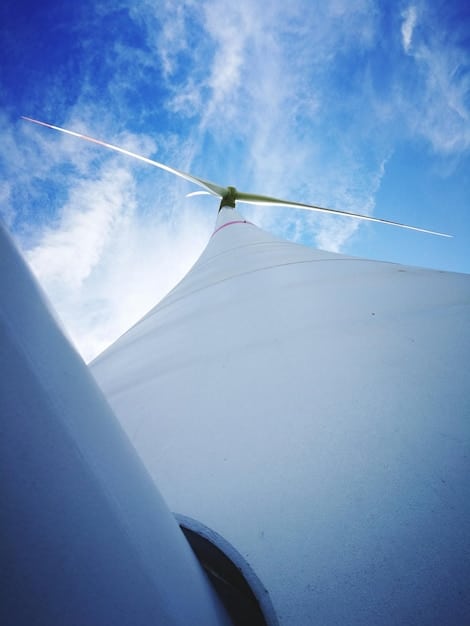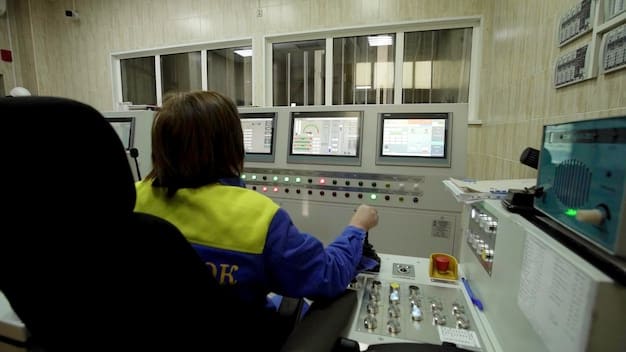US Energy Evolution: Meeting Climate Targets in the Next 25 Years

Over the next 25 years, the US energy mix will likely shift towards renewable sources like solar and wind, coupled with advancements in energy storage and grid modernization, to achieve ambitious climate targets and reduce reliance on fossil fuels.
The landscape of energy production and consumption in the United States is on the cusp of a major transformation. The question of how will the US energy mix evolve over the next 25 years to meet climate targets is not just a matter of policy; it’s a critical challenge that requires innovation, investment, and a fundamental shift in how we power our lives.
Understanding Current US Energy Mix and Climate Goals
To understand the future of US energy, it’s essential to grasp the current landscape and the ambitious climate goals driving change. The US energy mix today is a complex combination of fossil fuels, nuclear energy, and renewables, each with its own benefits and challenges.
Current Energy Sources
Currently, fossil fuels, including coal, natural gas, and petroleum, dominate the US energy supply. These sources have historically provided a reliable and affordable energy base, but their significant greenhouse gas emissions have made them a primary target for reduction.
- Coal: Once the dominant electricity source, coal use has been declining due to environmental concerns and the rise of cheaper natural gas and renewables.
- Natural Gas: A cleaner-burning fossil fuel, natural gas has become a major source of electricity and heating, but still contributes to greenhouse gas emissions.
- Petroleum: Primarily used for transportation, petroleum poses a significant challenge due to its carbon intensity and reliance on imports.
In contrast, renewable energy sources like solar, wind, and hydropower are growing rapidly. These sources offer clean, sustainable energy production but face challenges related to intermittency and infrastructure.

US Climate Goals
The US has set ambitious climate goals, aiming to achieve a net-zero emissions economy by 2050. This target requires significant changes in energy production, transportation, and industry.
- Paris Agreement: The US has rejoined the Paris Agreement, committing to reduce greenhouse gas emissions by 50-52% below 2005 levels by 2030.
- Net-Zero Emissions: The long-term goal of achieving net-zero emissions by 2050 requires a complete transformation of the energy system.
- Renewable Energy Standards: Many states have implemented renewable portfolio standards (RPS) that mandate a certain percentage of electricity to come from renewable sources.
Achieving these goals will require a multifaceted approach, including transitioning to renewable energy, improving energy efficiency, and developing carbon capture technologies. The transition will impact various sectors and necessitate strategic planning and investment.
The Rise of Renewable Energy: Predictions & Growth
Renewable energy is poised to play a central role in the future US energy mix. Rapid technological advancements and decreasing costs have made renewables increasingly competitive with traditional fossil fuels.
Solar Energy
Solar energy has experienced remarkable growth in recent years, driven by declining panel costs and supportive policies. Solar capacity is expected to continue expanding rapidly, with utility-scale solar farms and distributed rooftop solar systems becoming more prevalent.
Advancements in photovoltaic (PV) technology, such as improved panel efficiency and bifacial panels, are further enhancing the viability of solar energy. Additionally, the development of energy storage solutions is helping to address the intermittency challenges associated with solar power.
Wind Energy
Wind energy is another major renewable energy source with significant potential in the US. The country has abundant wind resources, particularly in the Midwest and Great Plains, making wind power a cost-effective energy option in these regions.
- Offshore Wind: The development of offshore wind farms along the Atlantic coast is expected to contribute significantly to wind energy capacity.
- Technological Improvements: Larger and more efficient wind turbines are increasing energy capture and reducing costs.
- Policy Support: Federal and state incentives, such as tax credits and renewable energy mandates, are driving wind energy growth.
Other Renewable Sources
While solar and wind are the leading renewable energy sources, other technologies also play a role in the future energy mix. Hydropower, geothermal, and biomass offer unique benefits and can contribute to a diversified energy portfolio.
- Hydropower: Existing hydropower plants provide a reliable source of renewable energy, and opportunities exist for retrofitting and upgrading facilities.
- Geothermal: Geothermal energy harnesses heat from the earth to generate electricity and provide heating and cooling.
- Biomass: Biomass energy uses organic matter to produce electricity, heat, and transportation fuels.
The growth of renewable energy is not without challenges. Intermittency, transmission constraints, and land use considerations need to be addressed to fully realize the potential of these clean energy sources.
The Role of Natural Gas and Nuclear Energy
While renewable energy is set to dominate the long-term energy mix, natural gas and nuclear energy will continue to play important roles in the transition. These sources offer reliability and can help bridge the gap as renewables scale up.
Natural Gas as Transition Fuel
Natural gas is often considered a transition fuel due to its lower carbon emissions compared to coal and petroleum. It can provide a flexible and dispatchable energy source to complement variable renewable energy.
However, the role of natural gas is increasingly debated as concerns about methane leakage and long-term climate impacts grow. Strategies to minimize methane emissions and explore alternative fuels, such as renewable natural gas and hydrogen, are essential.
Nuclear Energy
Nuclear energy provides a carbon-free source of electricity and has the potential to play a significant role in meeting climate targets. Existing nuclear power plants offer reliable baseload power, and new technologies, such as small modular reactors (SMRs), are being developed.

- Safety and Waste Disposal: Nuclear energy faces challenges related to safety concerns and the disposal of radioactive waste.
- Public Perception: Public perception of nuclear energy remains divided, influencing policy decisions and investment.
- Economic Competitiveness: The high capital costs of building nuclear power plants can make them less economically competitive compared to other energy sources.
The future of natural gas and nuclear energy will depend on technological advancements, policy decisions, and societal acceptance. Integrating these sources into a cleaner energy system requires careful planning and management.
Advancements in Energy Storage Technologies
Energy storage is a critical enabler of renewable energy integration. By storing excess energy generated during periods of high production, storage technologies can help address the intermittency challenges associated with solar and wind power.
Battery Storage
Battery storage has emerged as a leading energy storage technology, with lithium-ion batteries dominating the market. Battery storage systems can provide fast response times, making them ideal for grid stabilization and peak shaving.
- Grid-Scale Storage: Large-scale battery storage projects are being deployed to enhance grid reliability and integrate renewable energy.
- Residential Storage: Homeowners are increasingly adopting battery storage systems to store solar energy and provide backup power.
- Cost Reductions: The cost of battery storage has declined significantly in recent years, making it more economically viable.
Other Storage Technologies
In addition to battery storage, other technologies are being developed to provide long-duration energy storage. These technologies include pumped hydro storage, compressed air energy storage, and thermal energy storage.
The role of hydrogen
Hydrogen is emerging as a versatile energy carrier with the potential to decarbonize various sectors, including transportation, industry, and power generation. Hydrogen can be produced from renewable energy sources through electrolysis, offering a clean and sustainable energy pathway.
- Hydrogen as a Fuel: Hydrogen fuel cells can power vehicles, providing a zero-emission alternative to gasoline and diesel.
- Industrial Applications: Hydrogen can be used in industrial processes, such as steelmaking and chemical production, to reduce carbon emissions.
- Energy Storage: Hydrogen can be stored and used to generate electricity during periods of high demand, providing a flexible energy storage solution.
Advancements in energy storage technologies are essential for creating a reliable and resilient energy system powered by renewable sources. Continued innovation and investment in storage solutions are needed to accelerate the transition to a clean energy future.
Policy and Investment Driving the Transition
Policy and investment play a crucial role in driving the transition to a cleaner energy mix. Government policies, financial incentives, and private sector investments can accelerate the deployment of renewable energy and support the development of innovative technologies.
Government Policies
Government policies, such as tax credits, renewable energy mandates, and carbon pricing mechanisms, can create a favorable environment for renewable energy development. These policies can incentivize investments in clean energy and help level the playing field with fossil fuels.
Financial Incentives
Financial incentives, such as grants, loans, and loan guarantees, can reduce the upfront costs of renewable energy projects and attract private sector investment. These incentives can help overcome financial barriers and accelerate the deployment of clean energy technologies.
Private Sector Investment
Private sector investment is essential for scaling up renewable energy and developing innovative energy solutions. Venture capital, private equity, and corporate investments are driving innovation in areas such as energy storage, smart grids, and clean transportation.
The combination of supportive policies, financial incentives, and private sector investments can create a virtuous cycle, accelerating the transition to a cleaner and more sustainable energy system.
Challenges and Opportunities Ahead
The transition to a cleaner energy mix presents both challenges and opportunities. Addressing these challenges requires a comprehensive and coordinated approach, involving government, industry, and individuals.
One of the main challenges is the need to upgrade and modernize the electricity grid. The existing grid was designed for a centralized system powered by fossil fuels and is not well-suited for integrating distributed renewable energy sources. Investments in grid modernization, including smart grids and advanced transmission technologies, are essential for ensuring a reliable and resilient energy system.
- Grid Modernization: Smart grids and advanced transmission technologies are needed to integrate distributed renewable energy sources.
- Workforce Development: Training and education programs are needed to ensure a skilled workforce for the clean energy economy.
- Public Engagement: Public engagement and education are essential for building support for the clean energy transition.
The opportunities presented by the clean energy transition are significant. Investing in renewable energy and clean technologies can create jobs, stimulate economic growth, and improve public health. Embracing a cleaner energy future can lead to a more sustainable and prosperous society for all.
| Key Point | Brief Description |
|---|---|
| 💡 Renewable Energy Growth | Solar and wind will dominate, driven by cost declines and policy support. |
| ⚡ Energy Storage | Essential for grid stability, with batteries and hydrogen playing key roles. |
| 🎯 Policy & Investment | Government and private sectors must align to drive renewable deployment. |
| 🌐 Grid Modernization | Upgrading infrastructure is crucial for renewable energy integration. |
Frequently Asked Questions
▼
The main drivers include declining costs of renewables, increasing policy support, growing concerns about climate change, and technological advancements in energy storage.
▼
Energy storage helps to overcome the intermittency of renewables by storing excess energy and releasing it when needed, making renewable energy more reliable and dispatchable.
▼
Policy will play a crucial role through incentives, mandates, and regulations that promote renewable energy development and discourage fossil fuel consumption, accelerating the transition.
▼
Solar and wind energy are expected to experience the most significant growth due to their decreasing costs, technological advancements, and abundant resources in the US.
▼
Challenges include grid modernization, intermittency of renewables, high upfront costs, and the need for a skilled workforce and public support.
Conclusion
In conclusion, the US energy mix is on the cusp of a significant transformation, driven by climate goals and technological advancements. Renewable energy sources like solar and wind are poised to play a dominant role, supported by advancements in energy storage and strategic policy and investment decisions. Overcoming challenges related to grid modernization and public engagement will be crucial to achieving a sustainable and prosperous energy future.





